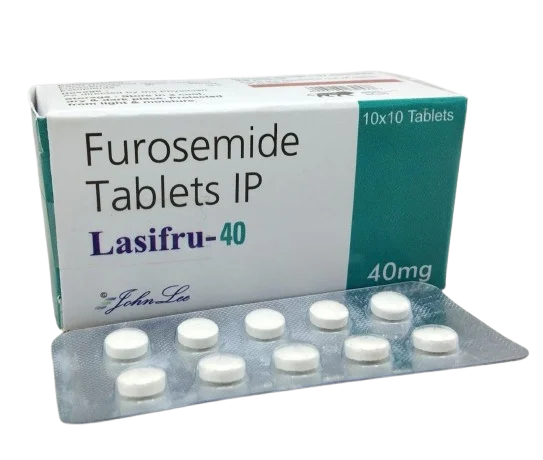Besides lowering BP, it helps manage kidney and liver-related swelling (edema) in conditions like cirrhosis and chronic kidney disease. Doctors add Furosemide 40 mg when other BP meds cannot enhance BP control in difficult-to-treat cases.
What is Furosemide 40 mg?
Furosemide is a loop diuretic, meaning it works on the loop of Henle, a part of the kidney responsible for controlling water and salt balance.
Step-by-Step Mechanism of Action
Blocks Sodium & Chloride Reabsorption
The body absorbs sodium (Na⁺) and chloride (Cl⁻) into the blood in the kidneys. Furosemide blocks this reabsorption of Henle, causing these salts to remain in the urine.
Increases Water Excretion
Since water follows sodium, the body loses more water through urine, reducing excess fluid in tissues and the bloodstream. It helps in conditions like edema (fluid retention) and high blood pressure.
Reduces Blood Volume & Pressure
By removing excess fluid, blood volume decreases, causing lower blood pressure and less strain on the heart.
Promotes Potassium Loss (Important!)
Furosemide also causes potassium (K⁺) loss. Hence, doctors may recommend a potassium supplement or a potassium-rich diet.
What are the Uses and Benefits of Furosemide 40 mg?
Furosemide 40 mg is a loop diuretic primarily used to remove excess fluid from the body and lower blood pressure. Doctors prescribe it for several conditions, such as fluid retention and cardiovascular health.
Uses of Furosemide 40 mg
High Blood Pressure (Hypertension)
Lowers blood pressure by reducing blood volume, making it easier for the heart to pump blood.
Often used in cases of resistant hypertension (when other BP meds do not work).
Edema (Fluid Retention)
Treats swelling in the legs, feet, lungs, and abdomen caused by:
- Heart failure (helps the heart work efficiently)
- Kidney disease (reduces water overload)
- Liver cirrhosis (removes excess fluid in ascites)
Pulmonary Edema (Fluid in Lungs)
Used in emergencies to remove fluid from the lungs, helping patients breathe easier.
Kidney Disease & Chronic Kidney Failure
Furosemide Tablet 40 mg helps the kidneys excrete excess water and waste, preventing complications like high potassium levels.
Hypercalcemia (High Calcium Levels)
Flushes out excess calcium through urine, preventing kidney stones and bone problems.
Rapid Water Removal for Medical Conditions
Used in conditions like brain swelling (cerebral edema) or fluid overload from IV therapy.
Benefits of Furosemide 40 mg
- Fast-acting–Works within 30–60 minutes (oral) or 5 minutes (IV).
- Potent diuretic–Removes large amounts of fluid efficiently.
- Reduces swelling–Provides relief from bloating, heavy legs, and breathlessness.
- Supports heart function–Reduces strain on the heart in heart failure patients.
- Used in resistant hypertension–Effective when other BP meds do not work.
- Helps in kidney & liver disease–Prevents complications related to fluid overload.
What are the Dosages of Furosemide 40 mg?
High Blood Pressure (Hypertension)
- Usual dose: 20–80mg per day (taken once or divided into two doses)
- Adjustments: The doctor may increase or decrease the dose based on blood pressure response.
Edema (Fluid Retention) in Heart, Kidney, or Liver Disease
- Starting dose: 20–80mg once daily
- Severe cases: The doctors can increase the dose every 6–8 hours until they manage the fluid retention.
- Maintenance dose: 20–40 mg daily or on alternate days
- Severe kidney disease: May require higher doses (up to 600mg/day) in divided doses.
Pulmonary Edema (Emergency Treatment–Fluid in Lungs)
- Initial dose: 40 mg IV (intravenous injection)
- If no effect in 1 hour: 80mg IV
- Oral maintenance dose: 40–80mg per day (to prevent fluid buildup).
Chronic Kidney Disease (CKD) & Severe Fluid Overload
- Starting dose: 40–80mg per day
- Severe cases: Up to 600mg daily, divided into multiple doses.
- Dialysis patients: High doses may be required to stimulate urine production.
For Hypercalcemia (High Calcium Levels)
- Dose: 80–100mg every 1–2 hours (with IV fluids)
- Maintenance: Adjusted based on calcium levels.
Older patients: Start with lower doses to avoid dehydration.
Children: Doctors prescribe doses based on weight (1 mg/kg per dose, max 6 mg/kg/day).
Liver disease patients: They may use lower doses to avoid excessive dehydration.
How to take Furosemide 40 mg?
Taking Furosemide 40 mg as prescribed is crucial to maximize benefits and avoid side effects like dehydration or electrolyte imbalance.
How to Take-Stepwise Instructions
- Take Furosemide Tablet 40 mg on an empty stomach–Best absorbed when taken 30–60 minutes before food.
- Swallow whole with a full glass of water.
- Morning dosage preferred–To avoid waking up at night to urinate.
- If you take Furosemide twice daily, take the second dose before 4 PM to prevent nighttime urination.
- Follow the doctor’s instructions carefully–Do not increase or decrease the dose without medical advice.
High Blood Pressure
Take once daily in the morning.
Check blood pressure regularly.
Edema (Fluid Retention)
Usually taken once daily or on alternate days.
Severe cases may require twice-daily dosing.
Pulmonary Edema (Emergency Cases)
Doctors give IV injections in the hospital for immediate action.
Doctors may prescribe oral tablets later for maintenance.
Kidney Disease or Heart Failure
These patients may need higher doses in divided doses throughout the day. Monitor kidney function and electrolytes regularly.
Hypercalcemia (High Calcium Levels)
Taken with IV fluids in hospital settings.
Avoid While Taking Furosemide
- Alcohol–This can increase dehydration and dizziness.
- Excess salt intake–Reduces effectiveness.
- Potassium-rich foods/supplements–Only take if prescribed (since Furosemide Tablet 40 mg lowers potassium).
- Skipping doses–This can lead to fluid buildup or high BP spikes.
Missed Dose
Take Furosemide as soon as you remember, but skip it if it is almost time for your next dose.
Do not double up to make up for a missed dose.
When Should I Avoid Furosemide 40 mg or Use Furosemide 40 mg Cautiously?
When to AVOID Furosemide 40 mg
Severe Dehydration
Furosemide removes water from the body, so if dehydrated, it can worsen the condition and cause low blood pressure, kidney failure, or shock.
Severe Kidney Disease or No Urine Output (Anuria)
If your kidneys are not producing urine, Furosemide will not be effective and may cause further kidney damage.
Severe Liver Disease (Hepatic Coma or Severe Cirrhosis)
Furosemide Tablet 40 mg can cause electrolyte imbalances that worsen liver function.
Special monitoring is required if used in liver conditions like ascites.
Low Potassium (Hypokalemia) or Low Sodium (Hyponatremia)
Furosemide further reduces potassium & sodium levels, which can lead to muscle weakness, irregular heartbeats, or seizures.
Allergy to Sulfa Drugs
Furosemide contains a sulfonamide group, so people with sulfa allergies should avoid it or use it cautiously.
Gout (High Uric Acid Levels)
Furosemide raises uric acid levels, which can trigger gout attacks.
Pregnancy & Breastfeeding
Not recommended during pregnancy. It may pass into breast milk, so one should avoid it while breastfeeding.
When to Use Furosemide 40 mg Cautiously
Diabetes
Furosemide can increase blood sugar levels, requiring careful monitoring.
Low Blood Pressure (Hypotension)
Since Furosemide Tablet 40 mg lowers BP, it can cause dizziness, fainting, or shock in people with already low BP.
Older Patients
They are more sensitive to dehydration and electrolyte imbalances. So they may need lower doses.
Heart Problems (Arrhythmias or Weak Heart Function)
Furosemide 40 mg can cause electrolyte disturbances, leading to irregular heartbeats (arrhythmias).
Hearing Problems
High doses of IV Furosemide 40 mg can cause temporary or permanent hearing loss (ototoxicity).
What are the Side effects of Furosemide 40 mg?
Common Furosemide 40 mg Side Effects
- Frequent urination (expected)–May last up to 6 hours after taking the dose.
- Dizziness or Lightheadedness–because of sudden drops in blood pressure.
- Dry Mouth & Thirst–Caused by fluid loss.
- Muscle Cramps or Weakness–because of low potassium (hypokalemia) or magnesium levels.
- Nausea or Upset Stomach–You can reduce this. Take it with food.
- Low Blood Pressure (Hypotension)–Can cause fainting, weakness, or blurry vision.
- Headache–because of dehydration or electrolyte imbalances.
Severe Furosemide 40 mg Side Effects
- Severe Dehydration–Symptoms: extreme thirst, dry skin, confusion, very little urine output.
- Electrolyte Imbalances–Signs include irregular heartbeat, muscle spasms, confusion, or numbness/tingling.
- Hearing Loss or Ringing in Ears (Ototoxicity)–Common with high IV doses.
- Severe Low Blood Pressure (Shock)–Can cause fainting or collapse.
- Severe Allergic Reaction–Symptoms: rash, swelling, trouble breathing (rare but serious).
- Gout Flare-ups–Due to increased uric acid levels.





